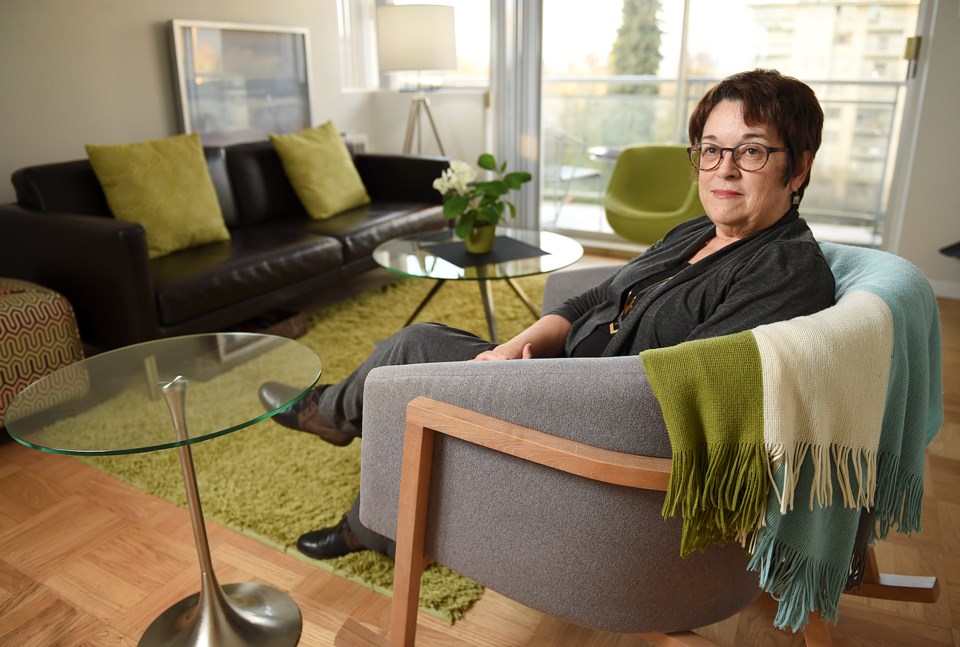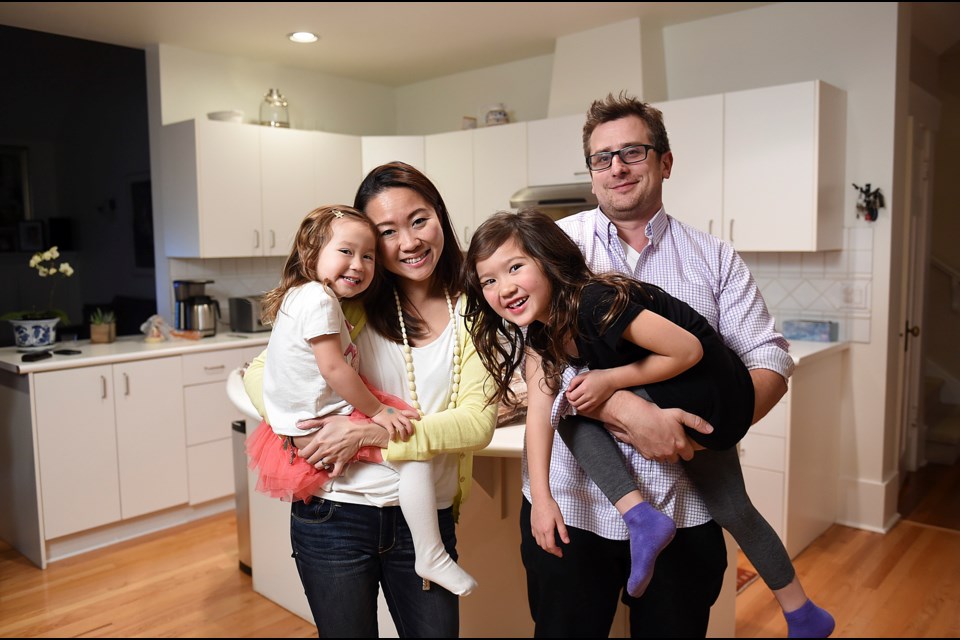Mike Lang is accustomed to small apartments with exorbitant rental and purchase prices — he recently returned to Vancouver from living in Hong Kong, one of the most expensive cities in the world.
So while he and his wife Cherie consider the recent acceleration in the city’s housing market “ridiculous” and not in any way tied to typical salaries, they’re prepared to settle for less than a stand-alone home with a big backyard.
They’re currently renting in Dunbar but want to buy a place to establish roots, stability and housing security for their two daughters, aged two and six.
They’re in a financial position to purchase their own condo, but the prospect of living in a building or neighbourhood hollowed out of families due to sky-high real estate prices doesn’t appeal. They want more than a place to live — they want connections and community.
A handful of Vancouverites have addressed this desire through cohousing, a type of collaborative living in which a group forms, finds and buys land and then designs and builds a complex. The complex features individual units that members purchase, as well as shared areas such as a common kitchen and outdoor space. Members usually hold some communal meals, make decisions by consensus and have responsibilities around the building.
Traditional cohousing isn’t cheap; members pay close to market rates, although there’s no developer markup since they act as the developer. Among the rewards, however, is the extra space and, most importantly, social relationships. One complex (Vancouver Cohousing) already exists in East Vancouver, while another (Little Mountain Cohousing) is going through the city’s rezoning process for a complex in the Riley Park neighbourhood.
But it takes time for projects to come to fruition. Lots of time, especially when it comes to assembling land in a city where single lots cost millions. It also requires a group to stick together and handle myriad details through the lengthy development period.
That’s where Our Urban Village comes in — it tweaked the cohousing concept and turned it into what’s been dubbed “cohousing lite.”
The Langs are among 19 families belonging to the group, which aims to work with a developer to realize their common goal. The developer would earmark a predetermined number of units within a development for the group to bulk purchase. That could mean, for example, buying several floors in a new condominium complex. They would also need some access to amenity space and one apartment to turn into a community space.
The upside: they don’t have to assemble the land, find professionals to make the project happen, work on nitty-gritty development details or push the project through city hall for approval. And there’s less time commitment for busy, young families. But at the end of the process, they move in and function like a traditional close-knit cohousing community.
The downside: they lose control over design, they likely won’t get a stand-alone complex and they’ll have to figure in the cost of a developer mark-up.
The Langs see cohousing as a great option for their family.
“We were OK with the idea of moving into a smaller place. We didn’t really feel like we needed a detached home or anything like that,” said 40-year-old Mike Lang. “[Part of it was] wanting to be part of a community and the feeling that a lot of developments in Vancouver are not really for people to live. It’s more like an investment. So even if you pay a lot of money for a place, you move in and there may or may not be a lot of other people there living with you. We wanted to have that community.”
Going with “cohousing lite” meant they could work with a developer who already had land and a development in the works, which Lang considers important given the cost and competitiveness for property.
He also noted that if you’re trying to buy a condo without being part of a cohousing group, you might have to sleep overnight to get a unit.
“[And] you may move into a place and find out your neighbours don’t even live there — it’s a bunch of empty apartments that are being Airbnb’d or rented out month-to-month,” he said.
“A big part of what we’re interested in is community and feeling connected to the people that live next to you — knowing I know my neighbour, I know them by name. Doing things within that community is very appealing to us. And, there’s a financial aspect of knowing that as a group there’s some cost certainty. It’s by no means cheap, but there are some cost certainties. We know ahead what we’re getting into and what we’re doing.”

Fitting in
Kathy Sayers, 68, grew up moving every two years. That’s why the prospect of living in a cohousing community appeals to her. She was involved in the original Little Mountain cohousing group, which didn’t gel, before becoming one of the founders of Our Urban Village.
It formed after she and others wondered if there was an easier way to establish cohousing than starting from scratch. The average cohousing project, she pointed out, takes four to six years to complete. Given Vancouver’s high land prices, they also realized future cohousing projects will likely end up looking similar because their footprints will be so small.
“[So] we just decided to look for a quality builder and try to slide our concept into a building. We’re looking to buy either three floors in a tower... or, naturally, we would prefer our own building or low-rise. But we decided to be as adaptable as we could for what was going on in Vancouver,” she said.
They checked with city hall and others to see whether it was a reasonable idea and, after visiting a small, nine-unit cohousing complex in Seattle, became convinced they didn’t need a huge amount of shared space.
“You can’t swing a cat without hitting a yoga studio in Vancouver, so do we really need that? So, we pulled back to what we considered the basic elements. In order to have community, you have to have common space. We’ll never get 6,200 square feet like Vancouver Cohousing — the Taj Mahal [of cohousing],” said Sayers. “Because of a historical accident, they pulled it off. They assembled that land at just the right time and that group stuck together. It’s an amazing community that stuck together through so much adversity to get it built. It’s a hard thing to do and they did a wonderful job. But we don’t think we could do it. That land now would cost [many millions]. It would be prohibitive to build.”
Our Urban Village, which held its first information session in July 2015, closed its membership off at 19 families because they’re not sure how many units they’ll ultimately be able to secure. (They also have 150 people in their email list.)
But they see cohousing lite as a way to get into a complex sooner through a model that works “good enough” for them.
“We’re giving, to our developer, the 20 per cent that [Vancouver Cohousing] saved. So we know we’re going to be paying market rates. And we also don’t get as much control over design, but we think we can do something that works,” Sayers said.
They identified six preferred neighbourhoods “where young families are, where there’s a sense of energy and growth,” and talked to about 13 developers. The group has one site that’s promising, which they can’t talk about yet, but they will be meeting soon to see if it’s “actionable.”
Three other developers are interested. One is trying to buy land with an eye to doing Our Urban Village’s project. The other two are farther out because their projects are big.
The group hopes to make a decision by January.
If they create a model that works, they hope others will be able to follow suit. They promised city council they’d document the process, providing a blueprint for cohousing lite. And, they’ll put interested groups in touch with developers whose sites they can’t use.
Sayers hopes more cohousing-style communities develop in Vancouver but she suspects the real estate market will make it difficult.
“It’s so hard to do with land prices what they are. There has to be another kind of model. And maybe it’s ours that’s kind of a compromise model. But there has to be [a way]. Young people want to stay in the city. They’re willing to live in smaller spaces if they get community. But they have to have that trade-off.”
Lang agrees there’s a demand.
“Our city is changing in different ways and people realize they want to get back to knowing people in their community,” he said.
@naoibh



